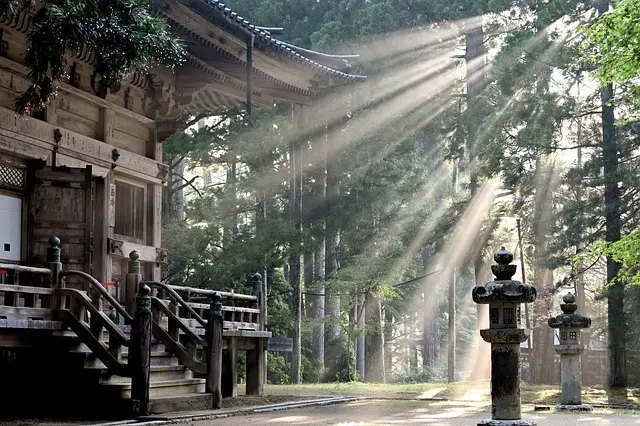
Essential Attractions in Nara City
1. Todaiji Temple
• Highlights: A symbolic landmark of Nara, home to the 15-meter-tall Great Buddha. The South Gate features two imposing guardian statues crafted by renowned sculptors of the Kamakura period.
• Recommended Visit Duration: 1.5–2 hours.
• Admission: Main Hall 500 yen; separate fees apply for the Ordination Hall and other areas.
2. Kasuga Taisha Shrine
• Highlights: A stunning red shrine surrounded by over 2,000 moss-covered stone lanterns. This is the head shrine of all Kasuga Shrines in Japan, founded during the Nara period.
• Recommended Visit Duration: 1–1.5 hours.
• Admission: Main Shrine 500 yen; Treasure Hall 400 yen; Man’yo Botanical Garden 500 yen.
3. Nara Park
• Highlights: A central hub of attractions, including free-roaming deer, Todaiji, Kasuga Taisha, and Mount Wakakusa. The park’s charm lies in its harmonious blend of nature and culture.
• Recommended Visit Duration: 2–3 hours, depending on activities.
• Deer Feeding: Deer crackers are sold for about 200 yen. Feed them cautiously.
4. Mount Wakakusa (Wakakusa-yama)
• Highlights: A panoramic viewpoint of Nara City. Known for its annual grass-burning event in January, it also offers spectacular views in all seasons.
• Recommended Visit Duration: 1 hour (if hiking).
• Admission: 200 yen during the spring and autumn open periods.
5. Toshodaiji Temple (Toshodai-ji)
• Highlights: Established by Chinese monk Jianzhen (Ganjin), this temple is a symbol of Sino-Japanese cultural exchange. Its ancient buildings are well-preserved examples of Heian-period architecture.
• Recommended Visit Duration: 1 hour.
• Admission: 600 yen.
6. Horyuji Temple (Horyu-ji)
• Highlights: Built during the Asuka period by Prince Shotoku, this UNESCO World Heritage Site is the world’s oldest wooden structure.
• Recommended Visit Duration: 2 hours.
• Admission: 1,500 yen.
Recommended Spots Around Nara
1. Asuka Village (Asuka-mura)
• Highlights: The cradle of Japan’s Asuka culture, featuring ancient sites such as Asuka Temple and Takamatsuzuka Tomb. A visit feels like a journey back to the Yamato period.
• Recommended Visit Duration: Half a day to a full day.
• Access: Take the Kintetsu Line to Asuka Station, then transfer to a bus.
2. Mount Yoshino (Yoshino-yama)
• Highlights: Famous for its cherry blossoms, Yoshino offers breathtaking views of “a thousand cherry trees at a glance.” The autumn foliage is equally stunning.
• Recommended Visit Duration: Half a day to a full day.
• Access: Take the Kintetsu Line to Yoshino Station, then hike or take a shuttle bus.
Suggested Itineraries
One-Day Itinerary
• Option 1 (Classic Route):
Kintetsu Nara Station → Kofukuji Temple → Todaiji Temple → Mount Wakakusa → Kasuga Taisha Shrine → Nara Park → Kintetsu Nara Station
Features: Covers the main attractions in Nara City, ideal for first-time visitors.
• Option 2 (Cultural Exploration):
Kintetsu Nara Station → Toshodaiji Temple → Yakushiji Temple → Todaiji Temple → Nara Park
Features: Adds cultural and historical depth with visits to Toshodaiji and Yakushiji Temples.
Three-Day Itinerary
• Day 1: Nara City Highlights
Kintetsu Nara Station → Kofukuji Temple → Todaiji Temple → Mount Wakakusa → Kasuga Taisha Shrine → Nara Park
• Day 2: Historical and Cultural Excursion
Yamatokoriyama Castle → Horyuji Temple → Shigisan Onsen (overnight at an onsen hotel)
Features: Combines visits to historical sites with a relaxing hot spring stay.
• Day 3: Yamato Cultural Discovery
Asuka Village → Kashihara Shrine → Fujiwara Palace Ruins
Features: Explores Japan’s first capital, showcasing the deep historical roots of the Yamato period.
Tips for First-Time Visitors
1. Transportation Advice:
• Within Nara City, most spots are accessible on foot. For further destinations, use Kintetsu or JR trains. A Nara sightseeing pass (e.g., Kintetsu Rail Pass) is highly recommended.
• Buses are the main transport option for reaching places like Asuka Village and Mount Yoshino. Check schedules in advance, as services can be infrequent.
2. Accommodation:
• Many visitors stay in Kyoto or Osaka and visit Nara as a day trip. If you prefer an immersive experience, consider staying near Nara Park or in an onsen hotel.
3. Deer Safety:
• While the deer in Nara Park are generally friendly, they may become assertive when food is present. Be cautious when feeding them, especially with children nearby.
Conclusion
Nara may be small, but its rich history and tranquil charm make it a destination worth exploring. Whether you’re visiting for a day or diving deeper into its culture over three days, this ancient city offers an unforgettable glimpse into Japan’s heritage.
